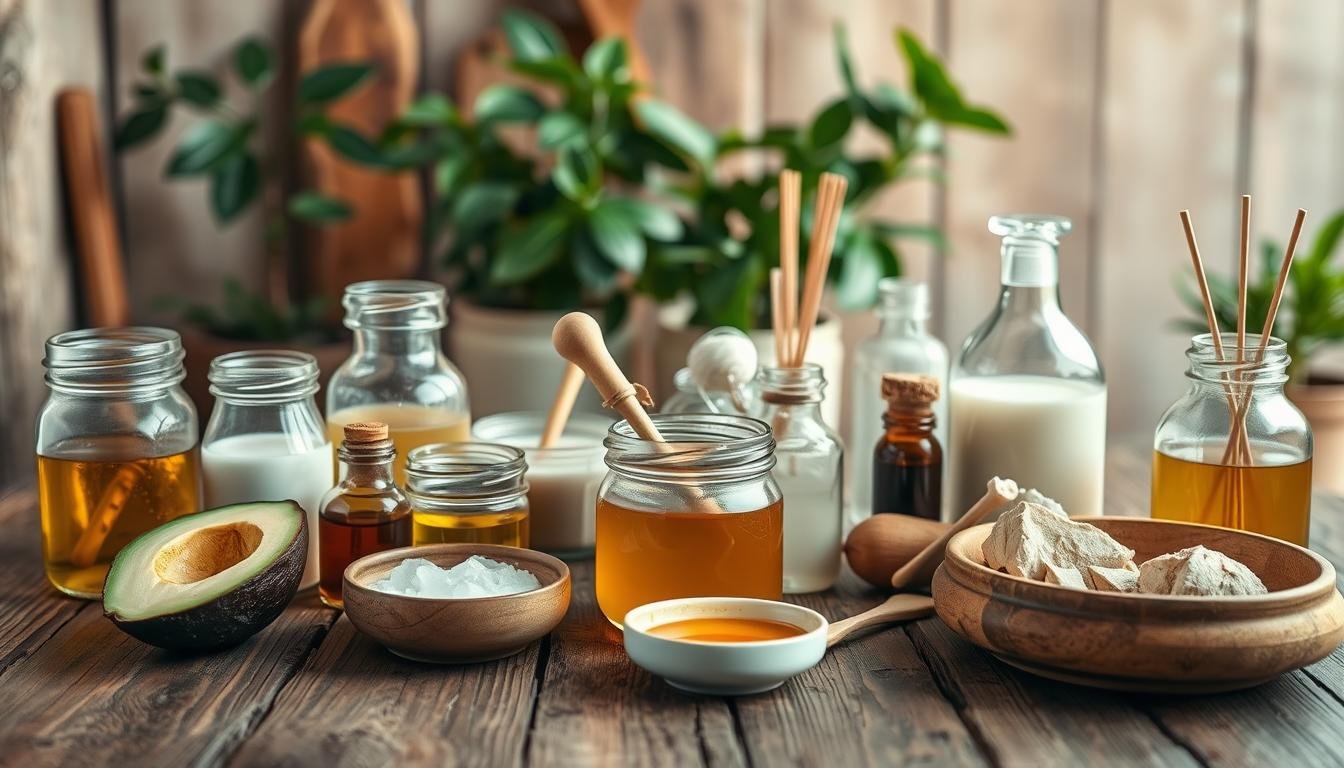Imagine transforming everyday pantry staples into luxurious treatments that rival high-end products. Could avocado, honey, or oats truly replace your store-bought serums and masks? The answer might surprise you.
More people are discovering the power of natural ingredients to address specific skin and hair needs. From soothing oatmeal face scrubs to coconut oil hair masks, these solutions let you skip harsh chemicals while saving money. You control every component that touches your body – no unpronounceable additives required.
This movement isn’t just about cost savings. It’s a shift toward mindful self-care and eco-friendly habits. By reusing containers and minimizing packaging waste, homemade routines align with sustainable living goals. Plus, customizing formulas for your unique needs creates a personal connection to your wellness journey.
Key Takeaways
- Create effective treatments using affordable kitchen ingredients
- Avoid synthetic additives found in many commercial products
- Tailor formulas to your specific skin type or hair texture
- Reduce environmental impact through reusable materials
- Achieve salon-quality results without premium prices
Introduction: The Rise of DIY Beauty Recipes
Kitchen counters are becoming the new beauty counters across America. Over the past five years, searches for homemade treatments surged by 300% as people grew tired of mystery ingredients in store-bought products. You now want to recognize every component touching your skin – no more guessing games with chemical-laden labels.
Social media platforms like TikTok and Instagram accelerated this shift. Creators demonstrate how avocado masks hydrate better than $50 serums, while oatmeal scrubs gently exfoliate. These tutorials make customized care accessible – you don’t need a cosmetology degree to mix effective formulas.
Economic pressures also play a role. When luxury creams hit $100 per jar, turning to pantry staples saves money without sacrificing results. During lockdowns, extra time at home let many perfect their mixing skills. What began as pandemic experiments became lasting habits for 68% of homemade product users.
Environmental concerns seal the deal. Reusable containers and bulk ingredients help reduce plastic waste from traditional packaging. By choosing natural alternatives, you’re not just nurturing your body – you’re making mindful choices that benefit the planet too.
Discover the Benefits of Homemade Beauty Remedies
Your bathroom shelf might hold more potential than you realize. Simple ingredients like honey, oats, and coconut oil can become powerful allies in your wellness routine. These solutions work with your body’s natural rhythms rather than against them.
Natural and Affordable Solutions
Store-bought products often contain alcohol or artificial fragrances that strip moisture from your skin. Homemade alternatives use gentle components like shea butter or aloe vera. A basic face mask might cost under $2 to make – compare that to $40 serums with similar active ingredients.
You’ll know exactly what’s nourishing your skin. No mystery preservatives. No hidden irritants. This approach lets you swap out ingredients based on seasonal needs or sensitivities.
Empowering Your Self-Care Routine
Mixing a scrub or mask becomes a ritual, not just a task. The process engages your senses – crushing rose petals releases their fragrance, while warm coconut oil feels soothing between your fingers. It’s care you can customize minute by minute.
Fresh ingredients mean maximum potency. That yogurt in your fridge? It’s packed with probiotics right now, not six months from now. Your creations adapt as your needs change, whether you’re tackling dryness or seeking glow-boosting antioxidants.
DIY beauty recipes: A Natural Approach to Skincare and Haircare
The secret to effective homemade treatments starts long before mixing begins. Choosing components with care ensures your creations work with your skin’s needs rather than against them. Let’s explore how to spot quality materials that deliver real results.
Spotting Top-Tier Components
Freshness matters when selecting items for your formulas. Look for vibrant colors in clays and herbs – faded tones suggest age. Carrier oils should smell clean, not rancid. Check expiration dates on packaging, especially for active elements like vitamin E oil.
Source from suppliers who share their farming practices. Reputable sellers provide details about organic certification and extraction methods. Cold-pressed oils retain more nutrients than heat-processed versions. Ask questions if information isn’t clear – transparency builds trust.
Understand label terms. “Natural” means nothing was synthetic, while “organic” requires certification. Avoid products listing “fragrance” without specifying origins. Store ingredients in dark glass containers away from heat to preserve potency. Oils last longest when refrigerated.
Different materials need specific handling. Butters stay creamy in cool spaces, while clays resist clumping in dry areas. Match storage solutions to each component’s needs, and your formulas will maintain their effectiveness for months.
Nourish Your Skin: Homemade Face Masks and Scrubs
Your spice rack might hold the secret to glowing, healthy skin. Simple combinations of kitchen staples can create treatments that address specific concerns like redness, dullness, or dryness. Let’s explore two powerhouse formulas that deliver salon-quality results without the premium price tag.

Turmeric and Honey Masks
Turmeric’s anti-inflammatory properties make it ideal for calming irritated skin. Mix 1 teaspoon of the golden powder with 2 tablespoons raw honey for a brightening treatment. The honey locks in moisture while fighting bacteria – perfect for combination or acne-prone skin types.
Apply the mixture to clean skin and leave it for 10 minutes. Rinse with cool water to reveal a more even tone. For extra hydration, add a spoonful of plain yogurt. Those with sensitive skin should patch-test first.
Coffee and Baking Soda Scrubs
Used coffee grounds make an excellent exfoliant packed with antioxidants. Combine them with baking soda and lemon juice for a refreshing scrub that removes dead cells. The citrus helps balance oil production while the baking soda gently buffs away impurities.
Massage the mixture onto damp skin using circular motions, focusing on rough areas like elbows or knees. Rinse thoroughly and follow with moisturizer. Limit use to twice weekly to avoid over-exfoliation.
Customize these recipes by adding oatmeal for extra soothing power or essential oils for aromatherapy benefits. Always store leftovers in airtight containers and use within three days for maximum freshness.
Revitalize Your Hair: DIY Treatments and Masks
Your kitchen holds hidden treasures for transforming dull strands into vibrant locks. Two simple ingredients – eggs and avocado oil – offer salon-level care without the chemicals. These treatments work with your hair’s natural structure to repair damage and boost shine.
Egg and Mayonnaise Deep Conditioning
Combine one beaten egg with two tablespoons of full-fat mayonnaise for a protein-packed hair mask. Egg proteins fill microscopic cracks in each strand, while the mayo’s oils seal moisture. Apply it section by section from roots to ends, focusing on dry areas.
Leave the mixture for 15 minutes before rinsing with cool water. Hot water cooks the egg – nobody wants scrambled proteins in their hair! Use this treatment weekly if you color-process or heat-style frequently.
Avocado Oil Scalp Massage
Warm three tablespoons of avocado oil between your palms. Massage it into your scalp using circular motions for five minutes. This stimulates blood flow while the oil’s vitamins penetrate hair follicles.
Adjust the amount based on your hair’s thickness – fine strands need one tablespoon, coarse textures might require four. Leave it overnight for deep conditioning or rinse after 30 minutes. You’ll notice less breakage within three uses.
Pair these routines with your regular wash days. Store leftover oil in a dark glass bottle to preserve nutrients. Your hair gains strength, while your skincare routine benefits from any excess oil rubbed into cuticles.
The Power of Natural Oils in Beauty Remedies
Your morning toast ingredients might moonlight as skincare superheroes. Two kitchen staples – coconut and olive oils – work wonders when applied topically. Their unique properties address everything from dryness to premature aging, making them versatile additions to your routine.

Nature’s Liquid Gold
Coconut oil absorbs faster than most moisturizers thanks to its medium-chain fatty acids. These molecules penetrate deeply without clogging pores, leaving your skin supple, not greasy. Its antibacterial qualities make it ideal for soothing irritation or minor cuts.
Olive oil fights time’s effects with antioxidants like vitamin E. These compounds neutralize free radicals that cause wrinkles. Warm a few drops between your palms before massaging into your body – it transforms into an overnight rejuvenation treatment.
| Oil Type | Key Benefits | Best For | Application Tips |
|---|---|---|---|
| Coconut | Fast absorption, antibacterial | Dry skin, hair masks | Use solid form for scrubs, liquid for serums |
| Olive | Antioxidant-rich, emollient | Mature skin, cuticle care | Mix with sugar for exfoliation |
Choose cold-pressed, unrefined versions for maximum potency. Combine coconut oil with lemon juice for a brightening face mask, or blend olive oil with coffee grounds for a cellulite-reducing scrub. Store them in amber bottles away from sunlight to preserve nutrients.
These oils adapt to your needs. Use coconut oil as a makeup remover that doubles as an overnight lip treatment. Olive oil becomes a luxurious bath additive when whisked with epsom salts. Your skin drinks up their goodness, one customized blend at a time.
Kitchen Ingredients That Transform Your Beauty Routine
Your grocery list doubles as a skincare menu when you know how to unlock hidden benefits. Ordinary items like honey and yogurt contain active compounds that address common concerns. Why pay premium prices when your fridge holds solutions for glowing skin and strong hair?
Raw honey acts as a natural humectant, drawing moisture into your body’s largest organ. Mix it with mashed banana for a hydrating hair mask – the fruit’s potassium smooths frizz while the honey seals split ends. For oily skin, apple cider vinegar balances pH levels when diluted as a toner.
Rice water’s amino acids strengthen strands better than many salon treatments. Soak uncooked grains overnight, then rinse hair with the starchy liquid. You’ll notice less breakage after three uses. Baking soda tackles multiple tasks: exfoliate elbows, clarify scalps, or absorb excess oil as dry shampoo.
These ingredients work because they’re packed with enzymes and vitamins your skin recognizes. Cucumber’s silica boosts collagen, while yogurt’s lactic acid gently removes dead cells. Store them properly – keep ground oats in airtight jars and refrigerate fresh blends – to maintain potency.
Build your beauty arsenal by matching food properties to needs. Dry skin? Try avocado’s fatty acids. Dull complexion? Citrus juices offer brightening vitamin C. Your kitchen becomes a lab where every experiment costs pennies and delivers visible results.
Crafting Creams and Lotions from Scratch
Shea butter’s velvety texture transforms basic ingredients into spa-worthy creams. This versatile base absorbs quickly while delivering lasting hydration. Unlike store-bought options, homemade formulas let you adjust thickness and fragrance to match your preferences.

Mastering Shea Butter Formulations
Start with unrefined shea butter for maximum nutrients. Melt it gently using a double boiler – overheating destroys its natural vitamins. Combine with coconut oil for lightweight moisture or cocoa butter for richer texture.
Balance is crucial. Use 60% butters to 40% carrier oils for stable cream that won’t separate. Add beeswax for firmer consistency in body balms. Always cool mixtures slowly to prevent graininess.
Customize with 10-15 drops of essential oils per cup. Lavender calms irritated skin, while tea tree fights blemishes. Vitamin E oil extends shelf life naturally. Store finished products in amber glass jars to block light degradation.
Plastic containers work for short-term use but can leach chemicals over time. Label each lotion with creation dates and ingredients. Most blends stay fresh 3-6 months when refrigerated.
Invigorating DIY Lip and Eye Treatments
Your delicate facial areas deserve specialized care that’s both gentle and effective. Discover how simple ingredients can refresh tired eyes and revive dry lips with spa-quality results.
Peppermint Lip Revival Scrub
Crushed candy canes become a festive exfoliant in this lip-softening formula. Mix 1 tablespoon with coconut oil and peppermint essential oil for a tingly scrub. The mint stimulates circulation while sugar buffs away flakes.
Apply in circular motions, then rinse. Your lips stay supple for hours. Use leftover candy or substitute with brown sugar for year-round use.
Blue Matcha Eye Renewal Cream
Shea butter forms the base of this nourishing cream, blended with butterfly pea flower powder. Known as blue matcha, this ingredient tightens eyes with natural astringents while boosting collagen.
Add evening primrose oil for hydration that lasts all day. The lavender-blue tint subtly brightens your eye area. Store in a cool place to maintain its velvety texture.
Both treatments let you pamper your body’s most sensitive zones using kitchen staples. Whip up small batches weekly for maximum freshness and potency.



